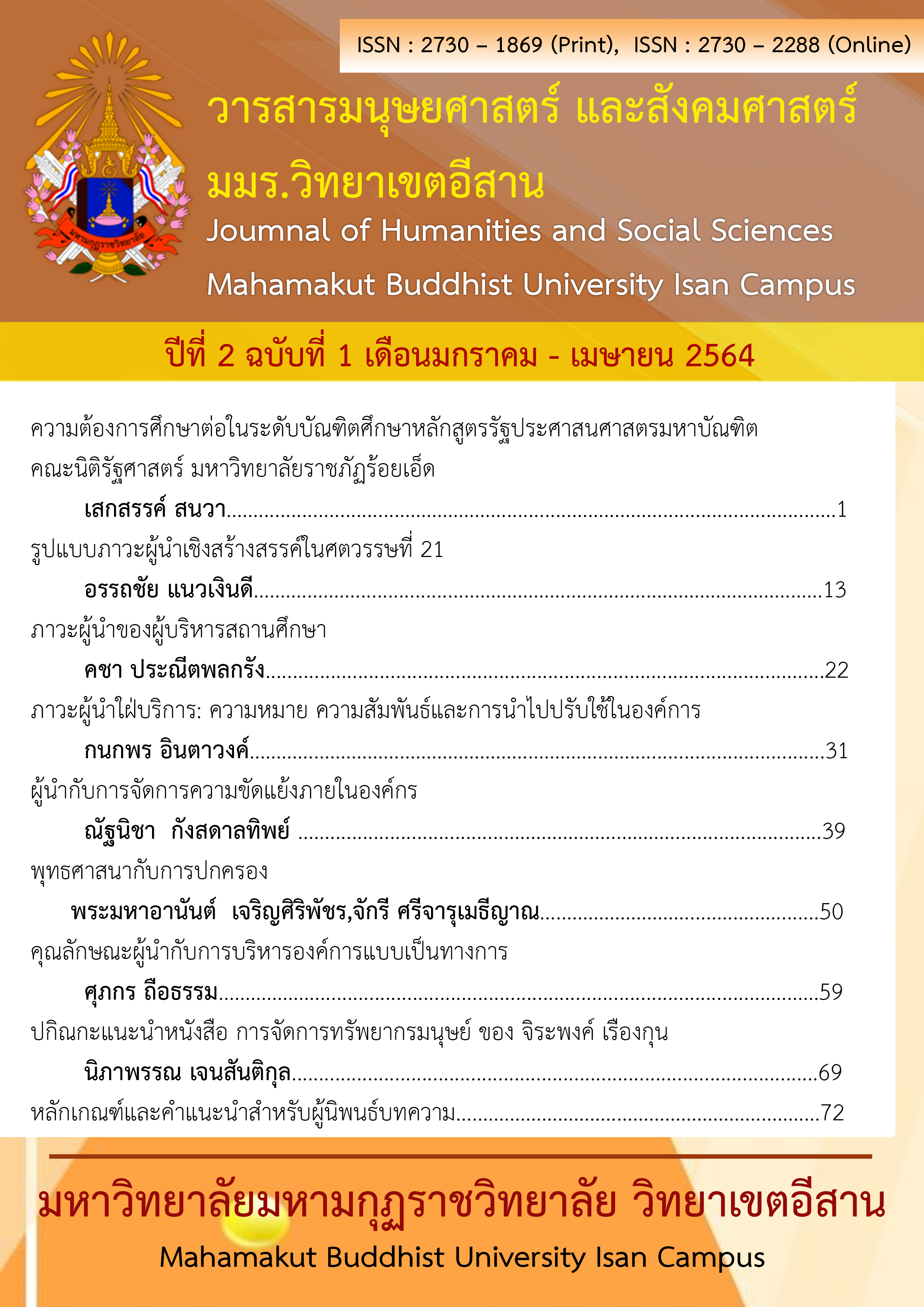Creative Leadership Model in the 21st Century
Keywords:
Leadership; Creativity; the 21st centuryAbstract
The objective of this article is to present the models and components of creative leadership in the 21st century. It was found that creative leadership model consists of creating an environment and an atmosphere of creativity, persuasion and motivation, clearly setting the working direction and having imagination in work. In terms of the creative leadership component had three components: 1) vision 2) imagination 3) individuality. The leaders must develop their own potential, plan for the future of the organization so that the organization was an organization that can keep up with the changes, know how to leverage technology or innovation in line with the 21st century changes.
References
กฤษพล อัมระนันท. (2559). การศึกษาภาวะผู้นำเชิงสร้างสรรค์ของผู้บริหารสถานศึกษาในอำเภอแม่วงก์. คณะครุศาสตร์ มหาวิทยาลัยราชภัฏนครสวรรค์.
ชาญชัย ศรีภิญโญ. (2563). ภาวะผู้นำสร้างสรรค์. คณะครุศาสตร์ มหาวิทยาลัยราชภัฏสวนสุนันทา.
ชาญชัย อาจินสมาจาร. (2550). ภาวะผู้นำในองค์กร. กรุงเทพฯ: ปัญญาชน.
ณัฐปาลิน นิลเป็ง. (2560). ผู้นำการเปลี่ยนแปลงในศตวรรษที่ 21. วารสารการพยาบาลและการดูแลสุขภาพ, 35 (1), 16-19.
ดุจเดือน ไชยพิชิต. (2561). การพัฒนาการจัดการเรียนรู้ในศตวรรษที่ 21 ของครูโรงเรียนตำรวจตะเวนชายแดนระดับประถมศึกษา จังหวัดอุบลราชธานี. วารสารวิทยาลัยบัณฑิตเอเซีย, 8 (1), 157-164.
นัยน์ปพร แก้วจีราสิน. (2561). ภาวะผู้นำเชิงสร้างสรรค์กับคุณภาพการศึกษาของโรงเรียนขยายโอกาสทางการศึกษาในจังหวัดนครปฐม. วิทยานิพนธ์ปริญญามหาบัณฑิต คณะศึกษาศาสตร์มหาวิทยาลัยศิลปากร.
บุญเลิศ อ่อนกูล. (2545). พฤติกรรมผู้นำของผู้บริหารโรงเรียนมัธยมศึกษาสังกัดกรมสามัญศึกษา จังหวัดราชบุรี. วิทยานิพนธ์ศึกษาศาสตรมหาบัณฑิต มหาวิทยาลัยศิลปากร.
บูรชัย ศิริมหาสาคร. (2549). ผู้นำพันธ์แท้. กรุงเทพฯ: สำนักพิมพ์แสงดาว.
ปุญญิสา พันธุภักดี. (2546). ความคิดเห็นของครูอาจารย์สังกัดกรมอาชีวศึกษาที่มีต่อพฤติกรรมการบริหารของผู้บริหาร: กรณีศึกษาจังหวัดกาญจนบุรี. วิทยานิพนธ์ ครุศาสตร มหาบัณฑิต มหาวิทยาลัยราชภัฏจันทรเกษม.
พระพิศาล วิสาโล และคณะ. (2560). ภาวะผู้นำเชิงปฏิสัมพันธ์ในศตวรรษที่ 21. วารสารวิชาการพระพุทธศาสนาเขตลุ่มแม่น้ำโขง, 1 (2), 81-84.
พิชาภพ พันธุ์แพ.(2556). ผู้นำกับการจัดการการเปลี่ยนแปลง. (พิมพ์ครั้งที่ 3). สำนักพิมพ์แห่งจุฬาลงกรณ์มหาวิทยาลัย.
พิเชษฐ์ วงศ์เกีรติ์ขจร. (2553). ผู้นำการบริหารยุคใหม่. (พิมพ์ครั้งที่ 1). กรุงเทพฯ: ปัญญาชน.
มูลนิธิยุวพัฒน์. (ม.ป.ป.) เปลี่ยนตัวเองสู่วัยรุ่นในศตวรรษที่ 21. [ออนไลน์] สืบค้นจากhttps://www.yuvabadhanafoundation.org/th. สืบค้นเมื่อ 8 ธันวาคม 2563.
สมชาย รุ่งเรือง และธีระวัฒน์ จันทึก. (2560). รูปแบบการพัฒนาผู้นำสู่การสร้างแรงผลักดันเชิงสร้างสรรค์. Veridian E-Journal, Silpakorn University, 10 (1), 29-46.
สมชาย เทพแสง. (2559). ภาวะผู้นำสมดุล: รูปแบบของผู้นำในคริสต์ศตวรรษที่ 21. วารสารบริหารการศึกษา มศว, 13 (24), 131-140.
สาคร ชิตงฺกโร และสัมฤทธิ กางเผ็ง. (2557). ภาวะผู้นำ เชิงจริยธรรม แนวคิด ทฤษฎีและการวิจัย. มหาสารคาม: อภิชาตการพิมพ์.
อาคม วัดไธสง. (2547). หน้าที่ผู้นำในการบริหารการศึกษา. สงขลา: มหาวิทยาลัยทักษิณ.
Ash, R. C. & Persall, J. M. (2007). The Principal as Chief Learning Officer. National Association of Secondary School Principal, 7 (84), 15-22.
Burns, J. M. (1978). Leadership. New York: Harper and Row.
Hemphill, J. K. & Coons, A. E. (1957). “Development of the Leader Behavior Description Questionnaire,” Stodgill, R. M., and Coons, A. E. (Eds.), Leader Behavior: Its Description and Measurement, Bureau of Business Research, Ohio State University, Columbus.
Magnusen, C. L. (2001). Spiritual Leadership in Educational Administration. Educational Administration Quarterly, 40 (2), 176-191.
Marquardt, M. J. (2000). Action Learning and Leadership. Learning Organization, 7 (5), 233 – 241.
Vétillart, G. (2014). Creativity & Leadership, The introduction of creative internal communication practices in organizations. Master Program, Leadership and Management in International Con, Sweden.
Yukl, G. (1994). Leadership in Organization. Englewood Cliffs, New Jersey: Prentice Hall Inc.



